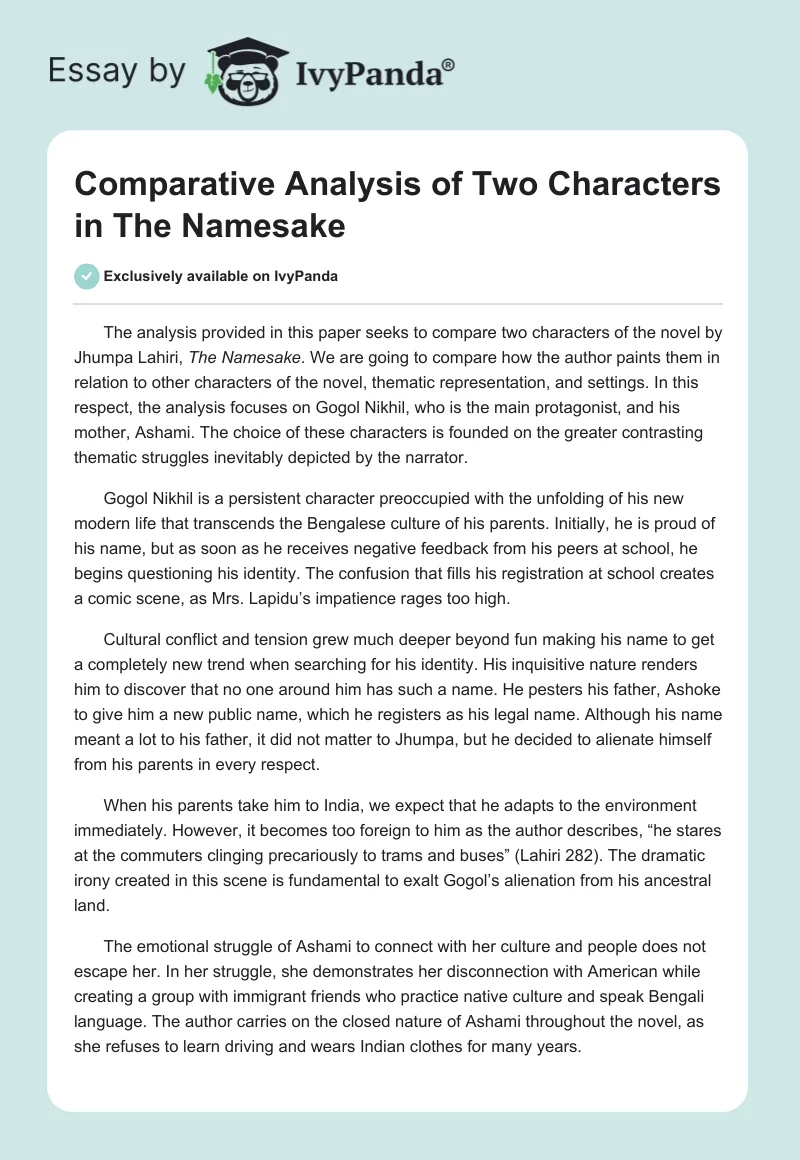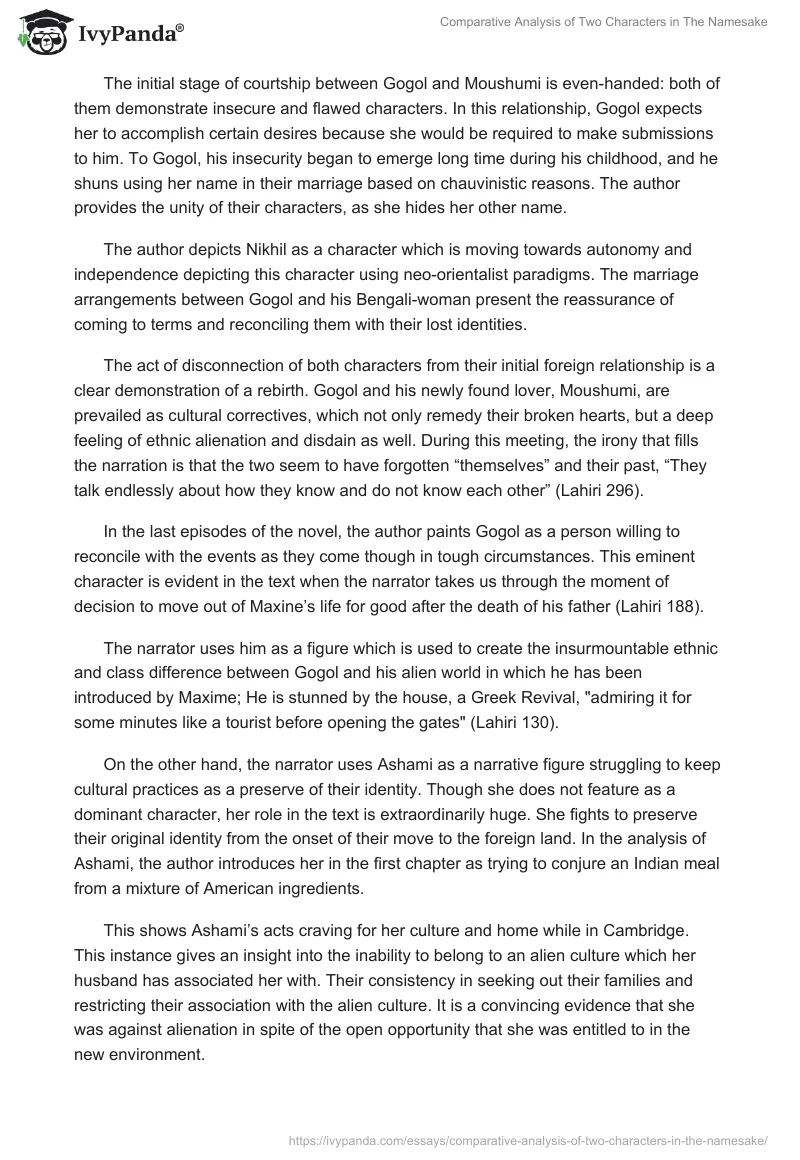The analysis provided in this paper seeks to compare two characters of the novel by Jhumpa Lahiri, The Namesake. We are going to compare how the author paints them in relation to other characters of the novel, thematic representation, and settings. In this respect, the analysis focuses on Gogol Nikhil, who is the main protagonist, and his mother, Ashami. The choice of these characters is founded on the greater contrasting thematic struggles inevitably depicted by the narrator.
Gogol Nikhil is a persistent character preoccupied with the unfolding of his new modern life that transcends the Bengalese culture of his parents. Initially, he is proud of his name, but as soon as he receives negative feedback from his peers at school, he begins questioning his identity. The confusion that fills his registration at school creates a comic scene, as Mrs. Lapidu’s impatience rages too high.
Cultural conflict and tension grew much deeper beyond fun making his name to get a completely new trend when searching for his identity. His inquisitive nature renders him to discover that no one around him has such a name. He pesters his father, Ashoke to give him a new public name, which he registers as his legal name. Although his name meant a lot to his father, it did not matter to Jhumpa, but he decided to alienate himself from his parents in every respect.
When his parents take him to India, we expect that he adapts to the environment immediately. However, it becomes too foreign to him as the author describes, “he stares at the commuters clinging precariously to trams and buses” (Lahiri 282). The dramatic irony created in this scene is fundamental to exalt Gogol’s alienation from his ancestral land.
The emotional struggle of Ashami to connect with her culture and people does not escape her. In her struggle, she demonstrates her disconnection with American while creating a group with immigrant friends who practice native culture and speak Bengali language. The author carries on the closed nature of Ashami throughout the novel, as she refuses to learn driving and wears Indian clothes for many years.
The initial stage of courtship between Gogol and Moushumi is even-handed: both of them demonstrate insecure and flawed characters. In this relationship, Gogol expects her to accomplish certain desires because she would be required to make submissions to him. To Gogol, his insecurity began to emerge long time during his childhood, and he shuns using her name in their marriage based on chauvinistic reasons. The author provides the unity of their characters, as she hides her other name.
The author depicts Nikhil as a character which is moving towards autonomy and independence depicting this character using neo-orientalist paradigms. The marriage arrangements between Gogol and his Bengali-woman present the reassurance of coming to terms and reconciling them with their lost identities.
The act of disconnection of both characters from their initial foreign relationship is a clear demonstration of a rebirth. Gogol and his newly found lover, Moushumi, are prevailed as cultural correctives, which not only remedy their broken hearts, but a deep feeling of ethnic alienation and disdain as well. During this meeting, the irony that fills the narration is that the two seem to have forgotten “themselves” and their past, “They talk endlessly about how they know and do not know each other” (Lahiri 296).
In the last episodes of the novel, the author paints Gogol as a person willing to reconcile with the events as they come though in tough circumstances. This eminent character is evident in the text when the narrator takes us through the moment of decision to move out of Maxine’s life for good after the death of his father (Lahiri 188).
The narrator uses him as a figure which is used to create the insurmountable ethnic and class difference between Gogol and his alien world in which he has been introduced by Maxime; He is stunned by the house, a Greek Revival, “admiring it for some minutes like a tourist before opening the gates” (Lahiri 130).
On the other hand, the narrator uses Ashami as a narrative figure struggling to keep cultural practices as a preserve of their identity. Though she does not feature as a dominant character, her role in the text is extraordinarily huge. She fights to preserve their original identity from the onset of their move to the foreign land. In the analysis of Ashami, the author introduces her in the first chapter as trying to conjure an Indian meal from a mixture of American ingredients.
This shows Ashami’s acts craving for her culture and home while in Cambridge. This instance gives an insight into the inability to belong to an alien culture which her husband has associated her with. Their consistency in seeking out their families and restricting their association with the alien culture. It is a convincing evidence that she was against alienation in spite of the open opportunity that she was entitled to in the new environment.
The concept of belonging enormously preoccupies the entire text with a contrast between Ashami and her first-born son, Gogol. Gogol was born in America, a land which is far away from his Bengalese background. His birth opens up the beginning of isolation from the realities of his original self.
Trying to protect their traditions, Ashami protests the Hospital compiler’s suggestion that they name their son. She says, “But sir, we can’t possibly name him by ourselves” (Lahiri 27). He insisted on her lack of intention to raise Gogol in a foreign land when she said to Ashoke “I am saying hurry up and finish your degree. I am saying I do not want to raise Gogol alone in this country. It is not right. I want to go back” (Lahiri 33).
This repeated insistence by Ashami reinforces her fears and needs to go back to their country where she can happily raise her family. She believes that a foreign land is not able to offer the best grooming to her only son who is in need to adapt to the culture of her home country well. At this moment, the narrator creates an early struggle for cultural autonomy between the alien American traditions perceived to be unfit, and the homeland culture.
In conclusion, the two characters have served to demonstrate the cultural tension and the struggle for retention and search for identity. The similarity between the two characters lies in the fact that both of them depict the major theme raised by the author. Although conflicting, their role in the text remains imperative in examining ideological friction and the quest for identity.
The author positions Gogol, the major male protagonist, as an accomplice of alienation through the second generation. He fights to turn-around the prevailing conservative traditions when he is born in a completely different environment perceived to be un-bearing by his predecessors. On the contrary, his mother, Ashami, perfectly positions herself as a figure to cushion against this emerging cultural protest staged by the birth of the second generation.
Work Cited
Lahiri, Jhumpa. The Namesake. New York: Houghton Mifflin Harcourt, 2004. Print.


